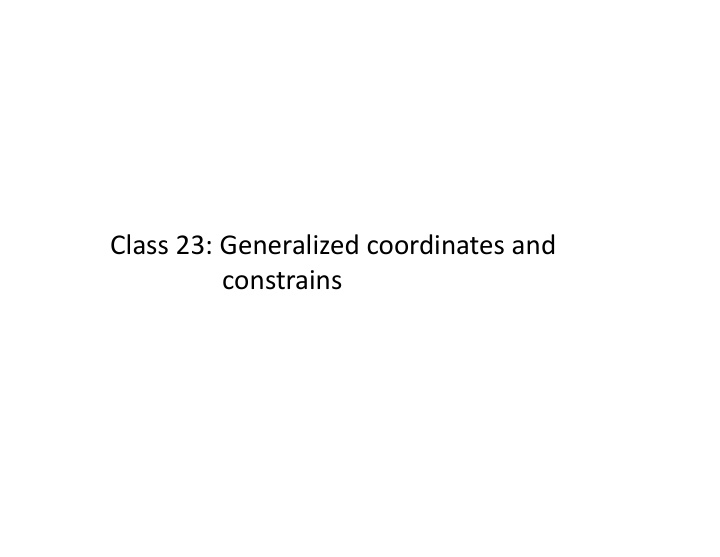



Class 23: Generalized coordinates and Class 23: Generalized coordinates and constrains
Euler ‐ Lagrange Equation – Special case 1 d f f - f f 0 0 dx y' y If f(y, y’, x) does not depend on y, (i.e. f(y, y’, x) = If f( ’ ) d t d d (i f( ’ ) f(y’, x) ) d f 0 f constant dx dx y' y y' y
Euler ‐ Lagrange Equation – Special case 2 d f f - f f 0 0 dx y' y If x is not in f(y, y’, x) explicitly, f y' - f constant y y'
Three equivalencies of analytical mechanics Newton’s Laws of Motion Analytical Mechanics Lagrange’s Hamilton’s Equation Equation Principle Principle
Start from Cartesian Coordinates It takes 3 coordinates (x, y, z) to determine the position of a particle and 3N coordinates to determine the position of N particle, and 3N coordinates to determine the position of N particles.
Holonomic constraints S Sometimes there is a relationship between the Cartesian ti th i l ti hi b t th C t i coordinates that can be described by an equation: f(x 1 , y 1 , z 1 , … , x N , y N ,z N )=0 If this equation can make one coordinate dependent of the If this equation can make one coordinate dependent of the others, then this equation is called a holonomic constrains. Example Example 1. If a particle is constrained to move in a circle on the x ‐ y plane, f(x, y) = (x 2 +y 2 ) 1/2 ‐ R=0 and there is only one independent coordinate (either x or y). 2. For N particles forming a rigid body, there are only 6 generalized coordinates. i.e. There are 3N ‐ 6 constraint equations between the original 3N coordinates.
Nonholonomic constraints Sometimes the constrains can be an inequality or differential form that show some kinds of relationship between the coordinates, but cannot be used directly to eliminate some di b b d di l li i coordinates. These constrains are known as nonholonomic constraints. Examples 1. If a particle is constrained to move freely outside a sphere of radius R: of radius R: (x 2 +y 2 +z 2 ) 1/2 R dx = a d cos 2. dy = ‐ a d sin dy a d sin
System with only Holonomic constraints If a system is moving only under holonomic constraints: 1. A set of independent coordinates can always be defined at the beginning of the problem. 2. 2. The number of independent coordinates is known as the The number of independent coordinates is known as the degree of freedom. 3. Only holonomic system can be handled systematically by analytical mechanics. 4. Constrains are the result of some constraining forces (e.g. normal force). These forces cease to exist in Lagrange ’s formulation.
Generalized Coordinates Cartesian coordinates are not the only way to specify the configuration of a system. Very Cartesian coordinates are not the only way to specify the configuration of a system Very often it is awkward to use Cartesian coordinates because these coordinates are constrained by complicated equations (e.g. particle move in a circle). It can be transformed to a set of generalized coordinates {q 1 , q 2 , q 3 , … q n } that are all independent by itself: r 1 = r 1 (q 1 , q 2 , q 3 , … q f ,t) r 2 = r 2 (q 1 , q 2 , q 3 , … q f ,t) ……. r N = r N (q 1 , q 2 , q 3 , … q f ,t) r N r N (q 1 , q 2 , q 3 , … q f ,t) Generalized coordinates is just a set of parameters used to define the configuration of a system. Note that these are just parameters and may not be related to vectors like the Cartesian coordinates. C t i di t Choice of generalized coordinates may not be unique, but the number of generalized coordinates must be the same in the same problem, equals to the degree of freedom of the p q g system. q i is just a parameter, it does not need to have the dimension of length (meter). The first step in solving a problem by Lagrange’s equation is to define the generalized coordinates.
My convention My convention It is my habit to “reserve” i and j as indices of Cartesian coordinates, k as indices of generalized coordinates, n as the total number of Cartesian coordinates, N=n/3, and f as degree of freedom
Recommend
More recommend